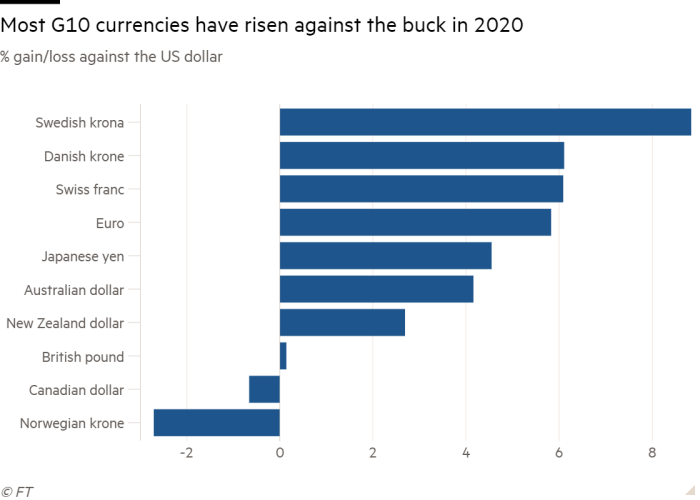Vaccine arrival expected to trigger dollar slump in 2021

Simply sign up to the Currencies myFT Digest -- delivered directly to your inbox.
Wall Street analysts expect the arrival of a vaccine against coronavirus to send the dollar sinking next year as confidence returns to the global economy.
Big banks with already negative views on the dollar for 2021 cut their forecasts further this month after clinical trials bolstered hopes that vaccines could become widely available next year, sparking an economic rebound that encourages a hunt for riskier bets.
The dollar is typically in demand in times of stress, reflecting its traditional role as a haven for investors and savers, as seen in a startling rally at the height of the coronavirus outbreak in March. Now some currency watchers believe a vaccine changes everything.
“Vaccine distribution we believe will check off all of our bear market signposts, allowing the dollar to follow a similar path to that it experienced from the early to mid-2000s,” Citi strategist Calvin Tse said in a research note. “Can the dollar decline 20 per cent next year alone? We think yes,” the bank added.
That would be a big move in currency terms. According to consensus forecasts compiled by Bloomberg, investors anticipate the dollar index will slip roughly 3 per cent from its current level by the end of next year. The median forecast is for the euro to reach $1.21 over that time period, from about $1.18 now.

A fall of 20 per cent for the dollar, on a trade-weighted basis, would be the biggest since the slide that started in 2001. But that 33 per cent drop took several years, when other currencies — particularly in emerging markets — pushed higher as investors sought out countries with higher interest rates and rapid growth. It lasted until the 2008 financial crisis.
Citi expects the US Federal Reserve to continue providing stimulus to the economy and to “err on the side of caution” before considering interest rate increases even as the global economic recovery speeds up. That could encourage investors to find a home for their money elsewhere, as rising inflation expectations in the US reduce the dollar's relative attractiveness and investors target faster-growing countries that may tighten monetary policy sooner.
The dollar index — a measure of the currency against six peers — has already declined this year, falling more than 4 per cent since the start of 2020, after the Fed wiped out some of the yield advantage US assets had enjoyed over their peers. The euro has gained nearly 6 per cent against the buck since January, while the Australian dollar has marched more than 4 per cent higher.
But this year’s drop in the dollar index is minor compared with its gains in previous years: it rose almost 13 per cent in 2014 and 9 per cent in 2015. Buying into US markets has been “almost unavoidable” over the past decade, according to analysts at Goldman Sachs, as corporate profits boomed and the Fed raised rates while many other central banks stayed closer to zero. This has made the currency expensive, setting it up for large falls ahead, said Zach Pandl, co-head of the bank’s global foreign exchange research. Goldman Sachs expects the dollar to slide 6 per cent on a trade-weighted basis over the next 12 months.

Mr Pandl said the currency should weaken even if the US economy gathers pace because of its role as a “barometer” of the health of the global economy, falling when growth is buoyant and rising at times of slowdowns.
“Even if the US economy performs quite well, we think the dollar can weaken substantially as investors look for higher returns outside of the US and exit the safe havens that they have been in throughout the Covid period,” he added.
Andrew Sheets, a cross-asset strategist at Morgan Stanley has pencilled in a 4 per cent drop in the dollar index and expects the Norwegian, Swedish, New Zealand and Australian currencies to outperform once the vaccine is widely available. The euro and emerging markets peers such as the Brazilian real, the South African rand and the Russian rouble also have room to appreciate against the buck, he said. Mr Sheets sees the euro trading at $1.25 by the end of next year.
“We are in the perfect environment for a rally in risky assets, a weaker dollar and stronger growth-sensitive currencies through the end of the year,” said George Saravelos, global head of currency research at Deutsche Bank.
But some strategists are decidedly more cautious, in light of the surge in coronavirus cases worldwide and the economic damage of renewed lockdown measures.
“We are just very bullish on the dollar as we go into year-end,” said Mark McCormick, global head of FX strategy at TD Securities. “Every single piece of good news has been emphasised and every single bad reality has been shoved aside.”
Analysts at Barclays have also flagged concerns that too small or too delayed a fiscal package from US policymakers could take the shine off risky assets and shore up demand for havens.
“Markets at some point have to respect the present tense rather than just look ahead,” added Mr McCormick.
Goldman’s Mr Pandl argues, however, that the positive vaccine trials significantly reduce investors’ hunger for safety. “The vaccine developments are sufficiently positive that most investors should be positioning for dollar weakness today,” he said.
Comments